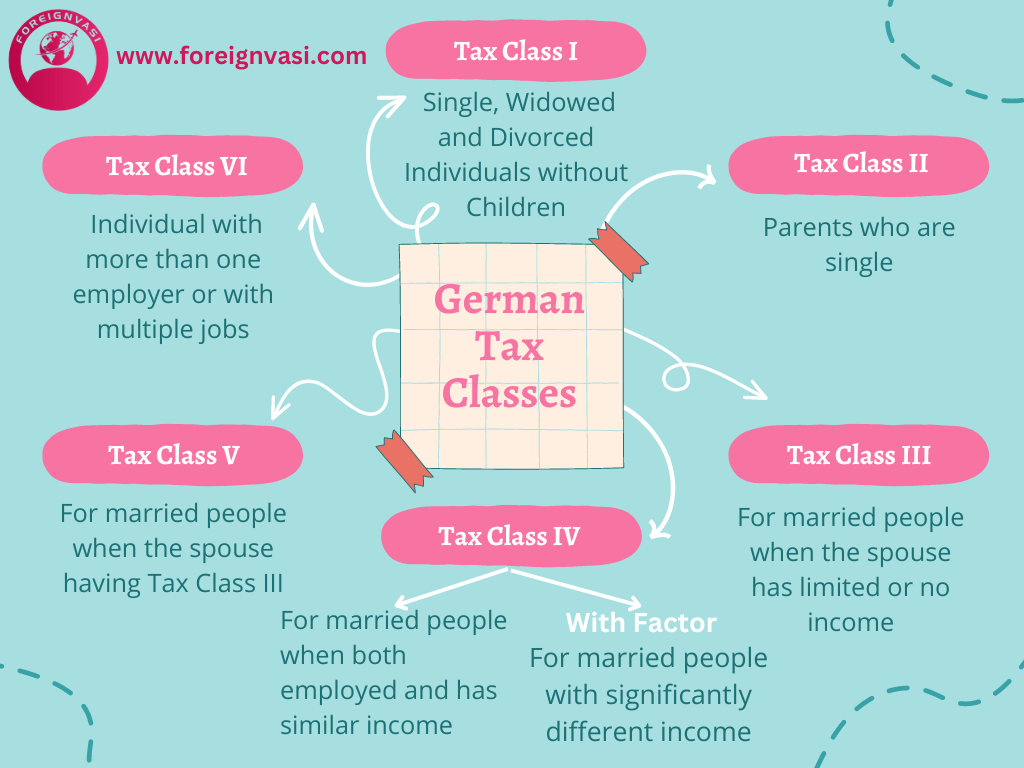German tax classes (Steuerklassen) explained. Find your tax class.
Introduction
Germany's tax system comprises of different tax classes which plays an important role to calculate the amount of income tax a household or an individual is liable to pay. Each tax class is corresponds to a particular tax rate that helps to determine the percentage of tax applicable to a person's income. This article gives you a breif of overview of the percentage of tax connected with tax class in Germany.
How many tax classes are there in Germany?
There are 6 tax classes in total and is assigned by the district tax office to every individual (employed or self-employed) based on martial status, the amount of money you earn, number of children, and tax allowances.

- Tax Class I: Single, Widowed Individuals, and Divorced Individuals without Children.
Tax Class I is applicable for people who are single, widowed, and are separated/divorced without children. The percentage of tax ranges from 14% - 42%, depends on the level of income.Following are the tax rates for 2023 in Tax Class ITax in % Income 0% Up to €9,744 14% - 42% €9,745 - €57,918 above 42% €57,918 - Tax Class II: Parents who are single
This class is especially for single parents (Divorced/Separated) living with their children. This tax class has additional tax relief when compared with Tax class I as the single parents are entitled to child allowance. The percentage of tax ranges from 14% - 42%. - Tax Class III: For married people when the spouse has limited or no income
This class applicable for married people, wife and husband living together and one of the spouse has limited income or not employed. The person with high income will have the Tax class III and on the other hand the person with low income or no income will have Tax class V. This tax class offers more favourable tax rate, which results in less tax percentages. The percentage of tax ranges from 14% - 42%.
- Tax Class IV:
- For married people when both employed and has similar income
This class is commonly used by married people living together and both of them are employed and receive almost same wages. Here in this class both spouses will have same tax class IV. The percentages of tax is same as Tax Class I. - For married people with significantly different incomes
This option of Tax Class IV with Factor exists for married people with significantly different incomes. The customized tax factor is applied by considering the income disparity. It means they won't need to pay any taxes directly. By considering the 'splitting advantage,' the tax office calculates the couple's anticipated tax liability and divides it into twelve monthly installments, which are withheld from their income (Einkommensteuer). This approach helps minimize the occurrence of owed back taxes within the bounds of the law.
- For married people when both employed and has similar income
- Tax Class V: For married people when the spouse having Tax Class III
This class applicable for married people, wife and husband living together and one of the spouse has Tax Class III. Similar to Tax Class IV, the percentage of tax is same as Tax Class I. - Tax Class VI: Individual with more than one employer or with multiple jobs
Tax Class VI is especially for people who works on multiple job simultaneously and receiving income from different employers need additional Tax class of VI. Ideally the lower income employment will get this tax class. The individuals ends up paying high taxes because of the progressive tax system. The percentages of tax is same as Tax Class I.
Conclusion
In conclusion, knowing the percentage of taxes linked with each tax class is necessary for households and individuals in Germany to correclty estimate their income tax liabilities. By understanding the tax rates that correspond to their specific tax class, the taxpayers can effectively plan their finances and fulfill their tax obligations. Utilizing online tax calculators or consulting a professinal tax consultant can provide further assistance in finding out the accurate tax percentage based on individual circumstances.